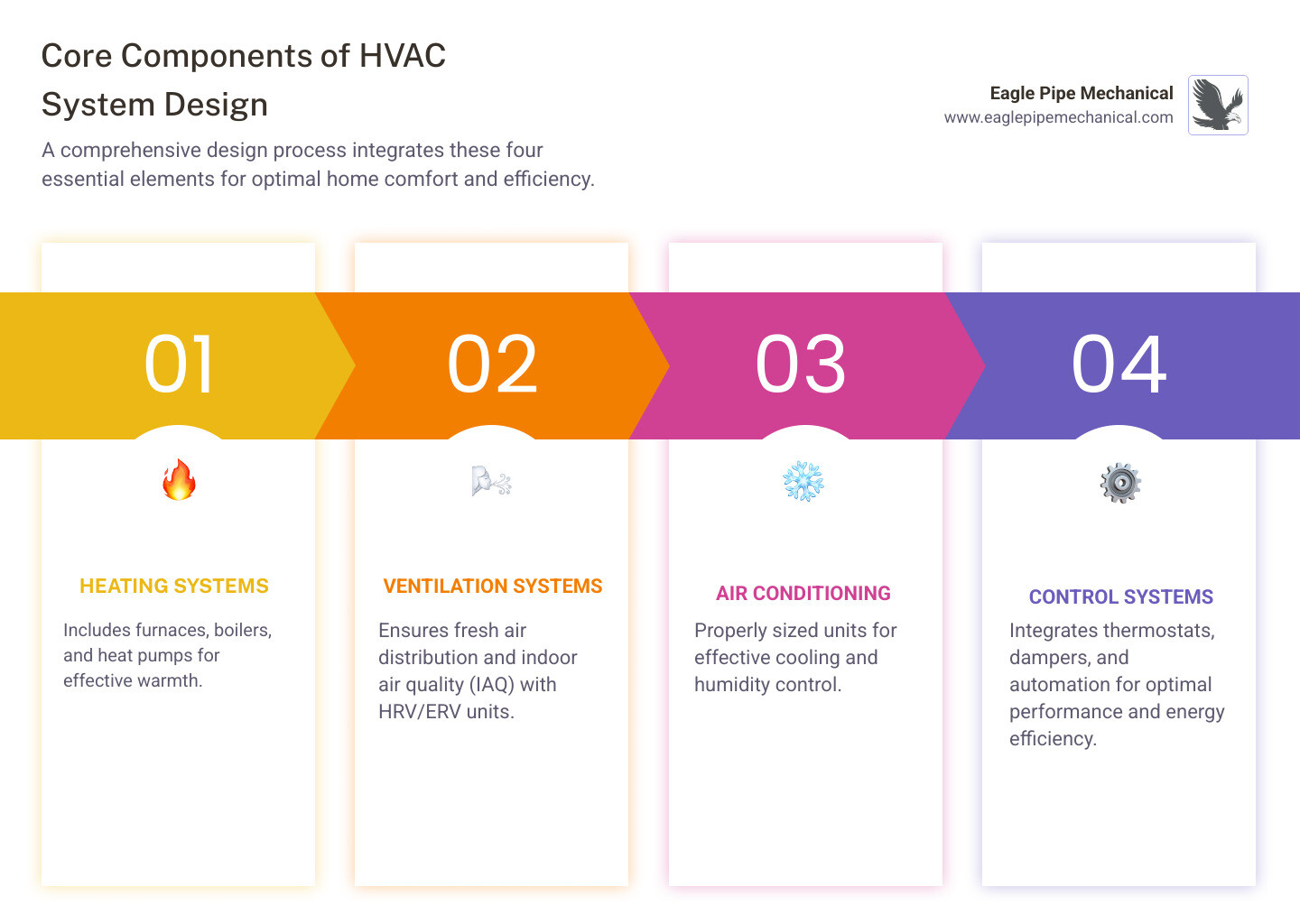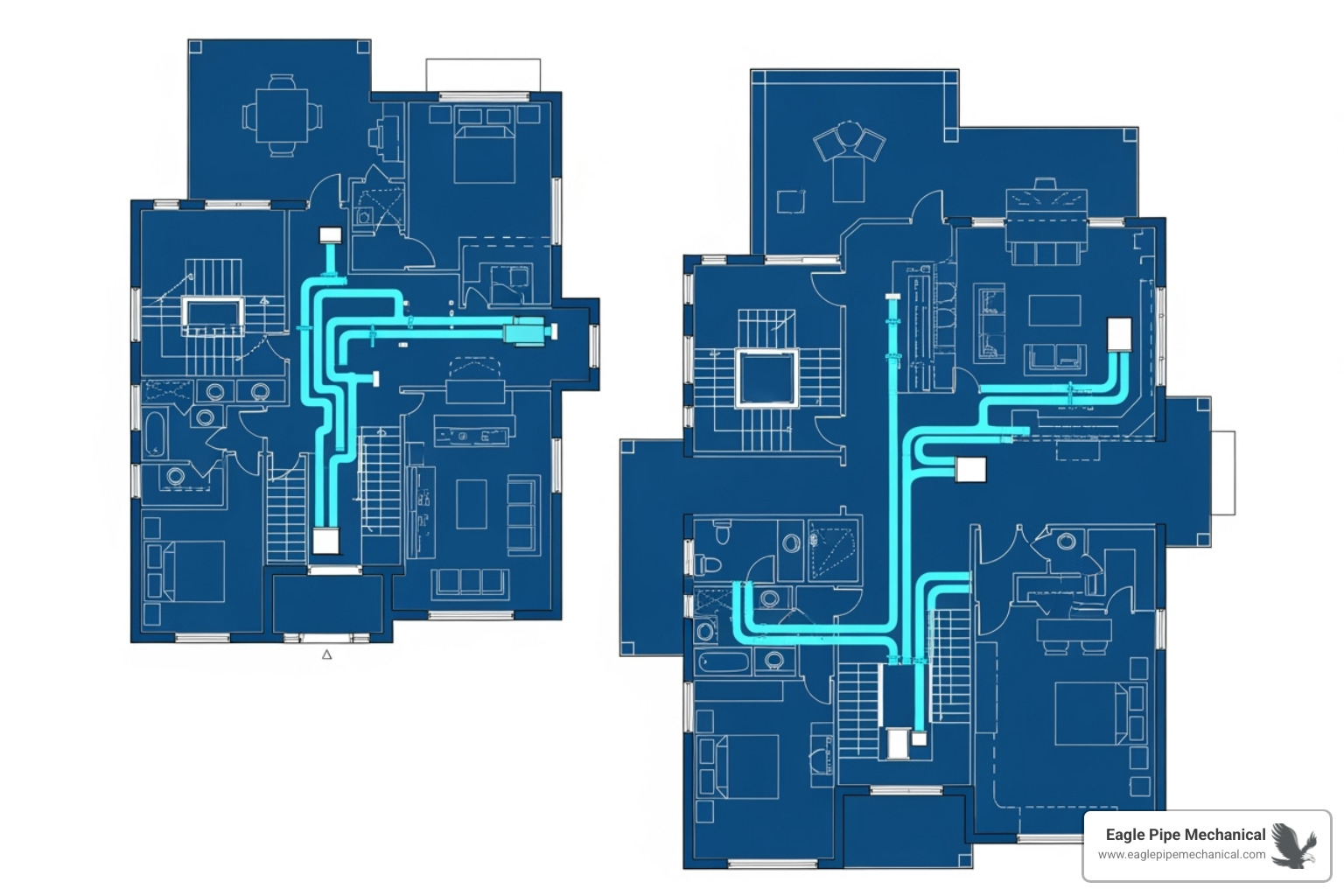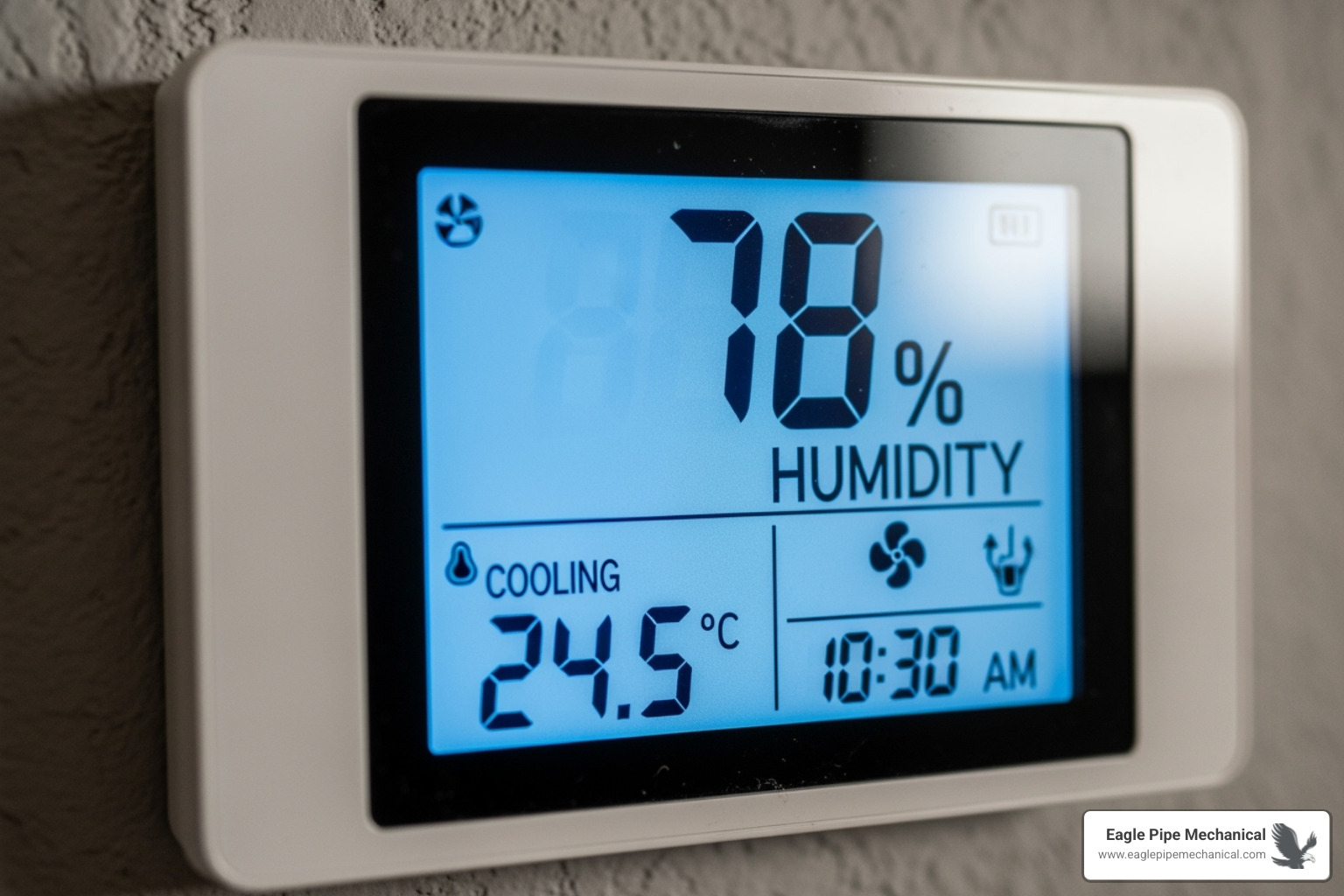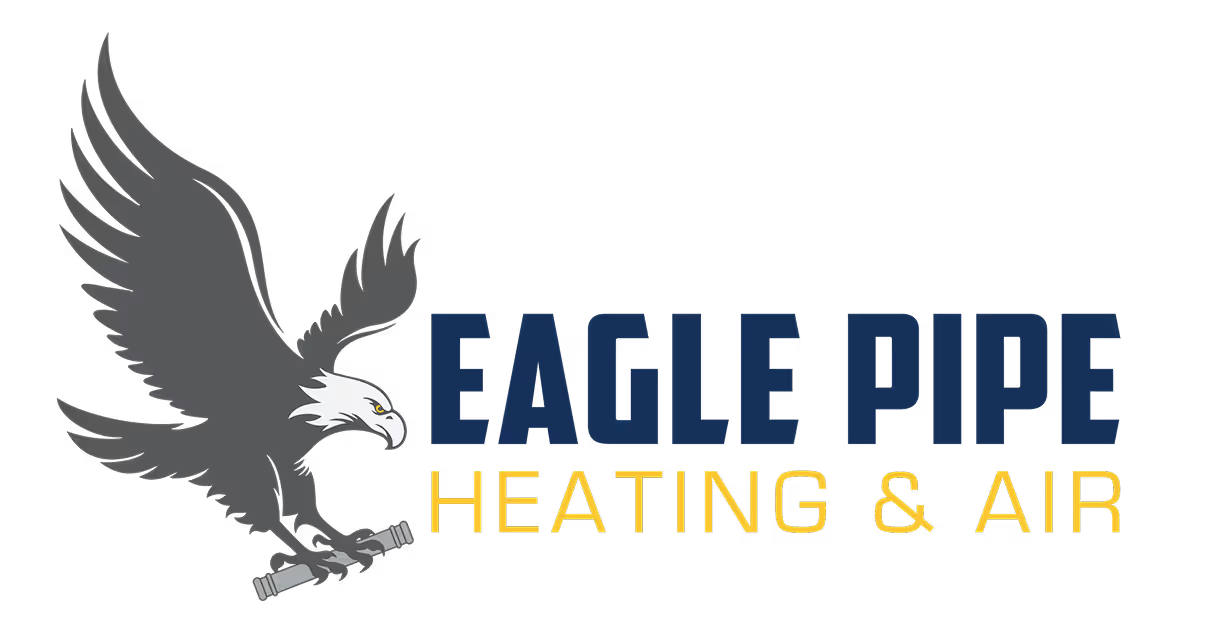The Art of Airflow: How to Design an Optimal HVAC System

Why Proper HVAC System Design is Critical for Your Home
HVAC system design is the foundation of home comfort. It's a detailed process that includes:
- Load calculations to determine your home's exact heating and cooling needs.
- Equipment selection of the right size and type of furnace, AC, or heat pump.
- Ductwork layout to plan airflow for even temperature distribution.
- Ventilation strategy to ensure fresh air and good indoor air quality.
- Control integration to coordinate thermostats and system operation.
A proper design is like a blueprint for your home's comfort system. Yet many comfort problems stem from poor initial design. The stakes are high. HVAC systems account for a significant portion of household energy use. When systems are improperly designed, you face:
- Comfort issues like hot and cold spots.
- High energy bills from inefficient equipment.
- Poor air quality due to inadequate ventilation.
- Premature equipment failure as systems are overworked.
In Kitsap and Jefferson Counties, our marine climate creates unique humidity and temperature challenges, making proper design even more critical. Your home needs a system engineered for our specific weather, not a one-size-fits-all approach. Following proven design standards like ACCA Manual J, S, and D can reduce HVAC-related energy consumption by up to 50% while ensuring optimal comfort.

The Foundation: Key Factors Influencing HVAC Design
A home's unique characteristics determine how its HVAC system will perform. Before selecting equipment, we must analyze the building envelope – your home's protective shell, including the roof, walls, floors, windows, and doors.
A home with a high insulation R-value (a measure of thermal resistance) keeps heat where you want it. Just as important is air tightness; even the best insulation is ineffective if your home has significant air leaks. Drafts around windows and doors force your HVAC system to work overtime.
Windows also play a huge role. The window U-factor measures how well they resist heat flow. Modern high-performance windows can dramatically reduce the load on your system.

Here in Kitsap and Jefferson Counties, our marine climate requires designs that account for our specific design temperatures and humidity levels. We plan for the coldest winter mornings and warmest summer afternoons.
Your family's occupancy and lifestyle patterns also influence the design. The number of people, work-from-home schedules, and heat-generating appliances all affect the heating and cooling load. Finally, the home's square footage and room layout dictate how air must be distributed. Following ASHRAE energy efficiency standards ensures systems are designed for long-term performance.
The Impact of Building Envelope
A well-built envelope can dramatically cut heating and cooling needs.
- Insulation is the first line of defense, acting as a thermal barrier. Proper insulation can reduce heating and cooling loads by up to 40%.
- Air sealing prevents drafts that compromise comfort and carry moisture and pollutants, impacting indoor air quality.
- High-performance windows (double or triple-pane) act as thermal shields. They help manage solar heat gain, letting in winter sun while blocking excessive summer heat.
- We also account for thermal bridging, where materials like wood studs create pathways for heat to bypass insulation.
Climate and Occupancy Considerations
Our Pacific Northwest weather creates unique demands. We use precise local weather data to design for our specific temperature and humidity extremes.
Humidity control is especially important here. High humidity can make a home feel muggy even at a comfortable temperature. Our designs account for both sensible heat (temperature) and latent heat (moisture removal).
Your family's needs are critical. The number of occupants, heat-generating appliances (ovens, dryers, TVs), and daily routines all influence the final design. These lifestyle usage patterns help us create a system that matches how you actually live.
A Step-by-Step Guide to HVAC System Design
Creating the perfect HVAC system design is a precise process following industry standards. We adhere to ACCA (Air Conditioning Contractors of America) protocols: Manual J for load calculations, Manual S for equipment selection, and Manual D for ductwork design. These standards are the difference between a system that performs beautifully for decades and one that causes constant frustration. The process integrates ventilation and system components, ensuring everything works together seamlessly.

Step 1: Performing Accurate Load Calculations (Manual J)
Manual J load calculations are the foundation of every successful HVAC system design. We don't use outdated rules of thumb like "500 square feet per ton of cooling." Your home is unique and requires precise calculations.
- Heat loss calculations determine how much warmth escapes on the coldest day, considering insulation R-values, window U-factors, and air tightness.
- Heat gain calculations measure heat buildup on the hottest day from sources like sunlight, appliances, and occupants.
A key part of this is a room-by-room analysis. We calculate the exact heating and cooling needed for each individual room to prevent hot and cold spots. We also factor in building materials and orientation, as a south-facing room with large windows has different needs than a north-facing one. This detailed approach ensures your system has the right capacity to be comfortable and efficient.
Step 2: Selecting the Right Equipment (Manual S)
Manual S guides the selection of equipment that matches your home's calculated loads. It's not about choosing the biggest unit. For heating, we select equipment with a capacity between 100% and 140% of the load. For cooling, the limit is 115% to avoid oversizing issues.
We consider both sensible heat (temperature) and latent heat (humidity). Your air conditioner must cool the air and remove moisture effectively. Part-load performance is also crucial, as systems rarely run at full capacity. We choose equipment that remains efficient during typical operating conditions. Options include traditional furnaces with air conditioners or modern air-source heat pumps. Energy Star certified heat pumps offer exceptional efficiency in our Pacific Northwest climate.
FeatureFurnaces (Gas/Propane)Air-Source Heat PumpsDuctless Mini-SplitsPrimary FunctionHeating (pairs with AC for cooling)Heating & Cooling in one unitZoned heating & coolingEnergy SourceNatural gas or propaneElectricityElectricityEfficiencyHigh-efficiency models reach 95%+Three times more efficient than gas heatingExtremely efficient for targeted comfortDuctwork RequiredYes, for whole-home comfortYes, for central systemsNo ducts neededBest for Our ClimateReliable heating with AC pairingExcellent choice for mild wintersPerfect for additions or specific rooms
Step 3: Creating an Efficient Ductwork Layout (Manual D)
Even the best equipment is useless if air can't get where it needs to go. Manual D is the standard for designing a home's ductwork system. Poorly designed ducts create comfort and efficiency problems.
We design for optimal airflow dynamics, creating smooth paths for air to travel and minimizing turbulence that wastes energy and creates noise. Every component creates friction loss, which increases static pressure and forces the system to work harder.
Supply and return placement is strategic. We position registers and grilles to ensure proper air circulation in every room. Duct sizing is also critical in our HVAC system design. Undersized ducts choke the system, while oversized ducts can reduce air velocity and create hot and cold spots. We use a trunk-and-branch design and calculate the exact size for each section to maintain balanced airflow. Duct materials are selected for durability and insulation, especially in unconditioned spaces like attics.
Step 4: Integrating Whole-Home Ventilation
Modern, energy-efficient homes are built tight, which can trap stale air. Whole-home ventilation is an essential part of a complete HVAC system design. We design a comprehensive strategy to bring in fresh air continuously while exhausting stale, polluted indoor air.
ASHRAE 62.2 standards guide us in determining the exact amount of fresh air your home needs based on its size and occupancy. Heat Recovery Ventilators (HRV) and Energy Recovery Ventilators (ERV) are key to efficient ventilation. These systems transfer 60-80% of the heat from outgoing stale air to incoming fresh air, saving energy. ERVs also transfer moisture, which is beneficial in our climate. Proper ventilation improves indoor air quality by controlling humidity and reducing indoor pollutants, ensuring your home is not just comfortable, but healthy.
The Perils of Poor Planning: Consequences of Improper Design
Poor HVAC system design leads to consequences that can last for decades. When systems aren't properly designed, you face persistent comfort problems, high energy bills, and frequent equipment breakdowns.
The negative effects impact your home life, from poor indoor air quality to potential building durability issues caused by moisture. Improperly designed gas systems can even create combustion safety issues.

Oversized and Undersized Systems
The "bigger is better" myth is particularly harmful in HVAC. An oversized air conditioner cools the house too quickly, satisfying the thermostat before it has a chance to remove humidity from the air.
This leads to short-cycling, where the AC turns on and off constantly. The result is a cold but clammy feeling and significant wasted energy. This constant starting and stopping also causes premature equipment failure. Oversized heating systems create similar problems, with hot spots and uneven temperatures.
Conversely, undersized systems simply can't keep up during peak weather conditions in Kitsap County. The system will run constantly without ever reaching the desired temperature. This leads to extreme discomfort, high energy bills, and a burned-out system from being overworked.
The Hidden Costs of Bad Ductwork
Even with perfectly sized equipment, bad ductwork can ruin system performance.
- Air leaks are a major energy thief. When ducts aren't sealed, conditioned air escapes into attics and crawlspaces, forcing you to pay to heat and cool unused spaces.
- Pressure imbalances create hot and cold spots, with some rooms getting too much air and others not enough.
- Noisy operation, such as whistling and rushing sounds, is a common sign of undersized or poorly designed ducts.
- Reduced efficiency is a direct result, as the system's fan works overtime to overcome leaks and restrictions, increasing electricity use and shortening the equipment's lifespan.
Investing in proper HVAC system design following Manual D standards is crucial for protecting your investment and ensuring long-term comfort.
Assembling Your Team and Your Documents
When you move forward with your HVAC system design, you're investing in an engineering process that requires the right expertise and documentation.
Who is Qualified for HVAC System Design?
Not everyone who installs HVAC systems is qualified to design them. Design requires specialized knowledge of building science, load calculations, and local codes.
- Mechanical engineers are ideal for complex projects, large homes, or unique architectural challenges due to their extensive training in building systems.
- Certified HVAC designers offer a great balance of expertise and cost-effectiveness for residential projects. They hold specific certifications and are registered with local authorities, ensuring they are current on codes and standards.
- Licensed contractors with design expertise are another option. A select few have invested in the training and software for proper HVAC system design, bringing both design and installation knowledge to a project.
At Eagle Pipe Mechanical, our team combines technical expertise with practical knowledge of our local climate in Kitsap and Jefferson Counties, ensuring your system is optimized for our Pacific Northwest environment.

What's in a Professional HVAC Design Package?
A professional HVAC system design package is a comprehensive collection of reports and drawings that guide the installation. It typically includes:
- The Manual J Load Calculation Report: A detailed, room-by-room analysis of your home's heating and cooling needs.
- Equipment Selection Documentation: Specifications for the furnace, AC, or heat pump that matches the load calculation, including performance and efficiency data.
- Detailed Ductwork Plans: Drawings showing the layout, size, and placement of all ducts, registers, and returns.
- Ventilation System Design: Specifications for fresh air systems (like an HRV or ERV) and their integration.
- Control Strategy Documentation: An outline of how thermostats and zoning systems will operate.
- Local Compliance Forms: All necessary paperwork for your local building department.
Understanding Costs and Timelines for your hvac system design
The investment in professional HVAC system design varies based on several factors.
- Project complexity is the main driver. A simple ranch home is less complex to design than a multi-story custom home.
- Home size and layout also play a role.
- New construction versus retrofit work can impact the cost and timeline, as retrofits require working around existing structures.
Based on industry standards, residential HVAC system design projects typically range from approximately $550 to $1,400. We provide transparent, customized quotes for every project.
Most residential design projects can be completed within 5-10 business days. The investment in professional design pays for itself many times over by preventing high energy costs, poor comfort, and premature equipment failure.
Frequently Asked Questions about HVAC System Design
Here are answers to some of the most common questions we hear about HVAC system design.
Can I design my own HVAC system?
While DIY is tempting, HVAC system design is not a suitable project for homeowners. Most building departments require plans from a qualified professional. The risks of mistakes are high, leading to incorrect calculations, comfort issues, wasted energy, and premature equipment failure.
Code compliance is non-negotiable. Professionals are current on safety, efficiency, and ventilation codes. They also use sophisticated Manual J software that provides far more accuracy than free online calculators. Your home's comfort and safety system deserves professional attention.
How does a zoned HVAC system work?
A zoned system allows you to set different temperatures in different areas of your home. This is achieved with:
- Multiple thermostats, each controlling a specific "zone" (e.g., upstairs, main floor).
- Motorized dampers inside the ductwork that open or close to direct conditioned air only to the zones that need it.
The benefits include customized comfort for everyone and significant energy savings (typically 10-15%) by not conditioning unused spaces. Zoned systems are especially effective in large or multi-level homes.
What is the most energy-efficient type of HVAC system?
The "best" system depends on your home and budget, but several technologies lead in efficiency.
- Geothermal systems are the most efficient, using the stable temperature of the earth for heating and cooling. The upfront cost is high, but long-term energy savings are substantial.
- High-efficiency air-source heat pumps are an excellent choice for the Pacific Northwest. Modern units are incredibly efficient and provide both heating and cooling.
- Condensing furnaces are the top choice for gas heating, with efficiencies over 95%.
Proper HVAC system design is key to selecting the right type of system and ensuring it is correctly sized for your home, which is the ultimate factor in achieving maximum efficiency.
Conclusion
Proper HVAC system design transforms a house into a home that provides comfort, health, and efficiency. It's a custom-fit solution made specifically for your property and lifestyle.
We've covered the importance of understanding your home's building envelope, our Pacific Northwest climate, and your family's needs. Following industry standards like Manual J, S, and D for load calculation, equipment selection, and ductwork design prevents costly mistakes like short-cycling, poor dehumidification, and high energy bills.
Cutting corners on design leads to expensive consequences. Professional HVAC system design is not a luxury—it's essential protection for your investment, ensuring comfort and preventing premature system failure.
Here in Kitsap and Jefferson Counties, we understand the challenges of our marine climate. At Eagle Pipe Mechanical, our mission is to deliver design and installation services optimized for our local community. An investment in professional design means years of reliable comfort, cleaner indoor air, lower energy costs, and peace of mind.
Your home should be a sanctuary with perfect temperatures and fresh air. Thoughtful HVAC system design delivers exactly that.
Ready to create the comfortable, efficient home you deserve? Let's design a system perfectly matched to your needs.
Get a professional HVAC installation for your new construction project
CUSTOMER TESTIMONIALS
Our customers’ experiences say more than we ever could. See how Eagle Pipe Heating & Air has earned trust across the Pacific Northwest with reliable service and lasting results.





